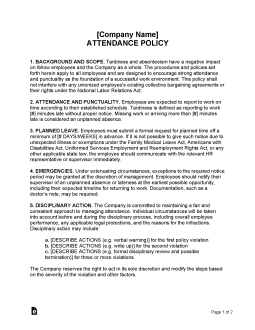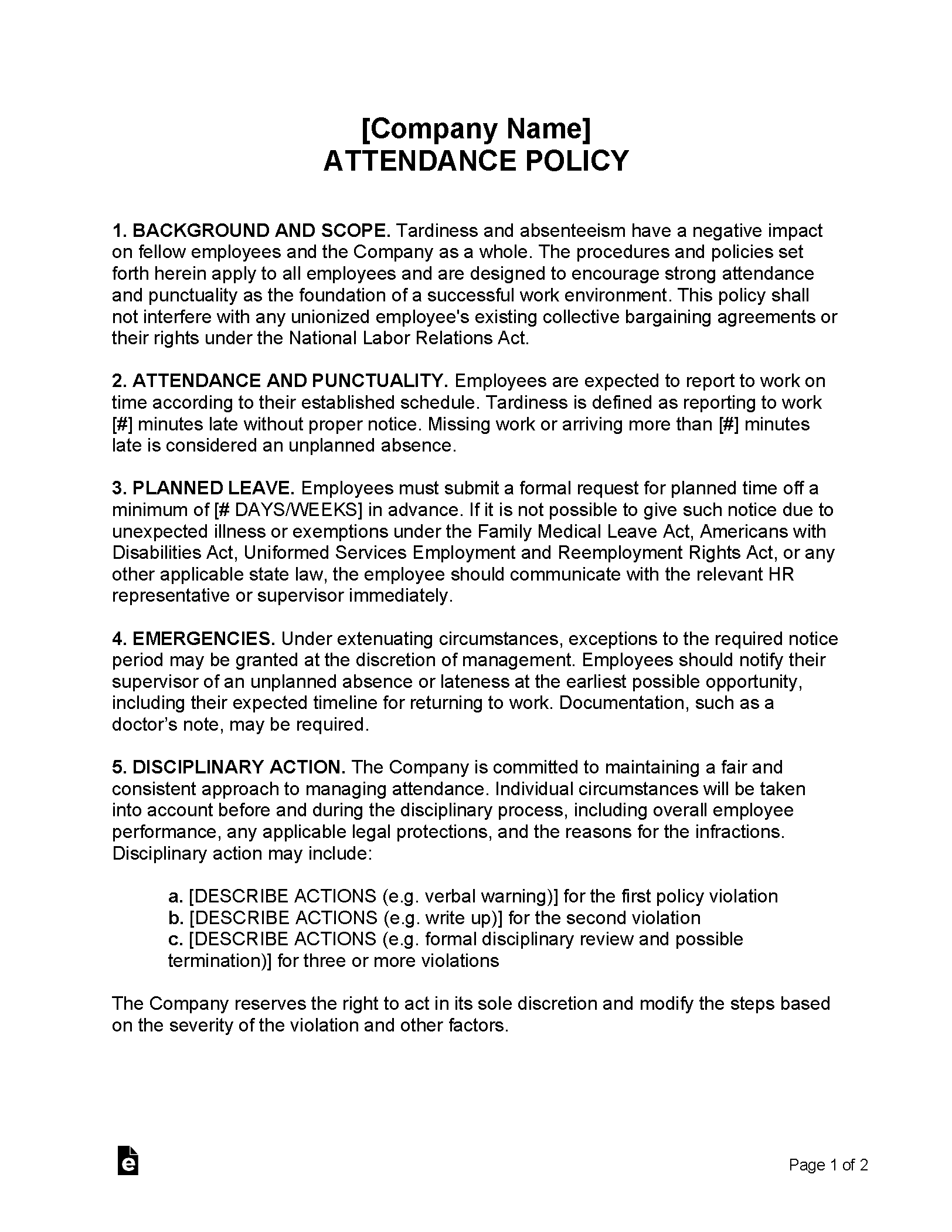Updated September 27, 2023
An attendance policy is a document formalizing the rules, expectations, procedures, and disciplinary actions regarding attendance and time off in a workplace. The policy should take into account the employer’s specific needs, requirements of the job, and existing company culture. A business usually presents its attendance policy to new employees for signature during onboarding.
Laws
Employer attendance policies must not violate the Family and Medical Leave Act (FMLA) or the Americans with Disabilities Act (ADA).
Table of Contents |
Benefits of Implementing a Formal Attendance Policy
Implementing a formal attendance policy benefits both employers and employees. Well-written attendance policies can minimize absenteeism, remove workflow interruptions, and increase productivity. By making expectations clear and allowing for regulated flexibility, they can also lead to improved employee morale and reduced turnover costs.
How Does Attendance Impact a Business?
Absences include missing work due to illness, injury, dependent care, and approved paid time off (PTO). Each year, missed work due to personal and family health issues costs U.S. employers roughly $1,685 per employee ($225.8 billion annually).[1] The average absence rate for full-time employees in the United States is 3.6%.[2]
Absenteeism occurs when an employee is absent from work without permission. Unexcused absences can be detrimental to company morale and finances, with impacts including administrative costs, lost revenue, replacement costs, and more.
Types of Absences
Some absences can be planned and excused in advance, but others occur unexpectedly. Common causes of workplace absence include planned vacations, medical issues, mental health, and workplace harassment.
Scheduled Absences
A scheduled absence is arranged between the employee and employer before the absence takes place. Attendance policies should include the appropriate procedure for scheduling an absence in advance. Employees may need to schedule absences for any of the following reasons:
- Eligible paid time off (PTO)
- Jury duty
- Medical leave of absence
- Parental leave of absence
- Personal or religious holidays
- Remote work days
Unscheduled Absences
An unscheduled absence occurs when an employee fails to show up for work without notice. Employers may excuse unscheduled absences at their discretion. Types of unscheduled absences include:
- Emergencies
- Unexpected illness
- Job abandonment
- No-call, no-show
- Tardiness
Attendance Management
Employees show up and produce their best work when they are happy and healthy. A well-defined attendance policy is an important step toward reducing attendance-related workplace issues, but the written policy is only one piece of the puzzle.
It can be useful to offer tools and incentives to maximize compliance, including remote work options, flexible hours, health and wellness resources, and rewards for good attendance. When an employee is chronically late or absent, non-disciplinary solutions such as time management training or individual mentorship may help address the issue.
Disciplinary Actions for Unexcused Absences
Employers can determine how many absences will lead to disciplinary action and whether repeat offenses call for more severe consequences.
A tiered system with verbal and written warnings as a first response is commonly used. Some companies use a “no-fault” attendance policy whereby employees accumulate “points” per absence until they reach the limit of unexcused points. When issues persist beyond those initial measures, more substantial actions may include:
- PTO deduction
- Disciplinary meeting
- Performance improvement plan
- Suspension
- Demotion
- Termination
Creating an Attendance Policy
To create an effective attendance policy, employers should consider what is appropriate given the company structure and culture. An attendance policy for a traditional or remote office environment will be different from that of a shift-based workplace. Simple, straightforward policies tend to maximize compliance.
Attendance policies can be included as an attachment in an employment contract that the employee signs when beginning work, distributed on or ahead of an employee’s first day, or otherwise provided in a way that gives the employee adequate notice of the policy.
What to Include
All workplace attendance policies should clearly outline expectations, describe the potential consequences of non-compliance, and acknowledge the legal rights of both the company and the employees.
Attendance Expectations
Explain the general rules regarding attendance and punctuality. Emphasize the importance of good attendance for a thriving workplace.
Definitions and Examples
Clearly define what constitutes excused absences, unexcused absences, and tardiness. Spell out the process for providing notice of a planned or unplanned absence.
Disciplinary Action
Specify the consequences of non-compliance. Many employers start with a written warning for first-time violations and continue the disciplinary process up to termination.
Exceptions
Make note of the process for granting exceptions due to extenuating circumstances, such as unforeseen emergencies.
Employee Acknowledgement
Include an area for employee acknowledgment and signature.
Sample
[Company Name]
ATTENDANCE POLICY
1. BACKGROUND AND SCOPE. The procedures and policies set forth herein apply to all employees and shall not interfere with any unionized employee’s existing collective bargaining agreements or their rights under the National Labor Relations Act.
2. ATTENDANCE AND PUNCTUALITY. Employees are expected to report to work on time according to their established schedule. Tardiness is defined as reporting to work [#] minutes late without proper notice. Missing work or arriving more than [#] minutes late is considered an unplanned absence.
3. PLANNED LEAVE. Employees must submit a formal request for planned time off a minimum of [# DAYS/WEEKS] in advance. If it is not possible to give such notice due to unexpected illness or exemptions under the Family Medical Leave Act, Americans with Disabilities Act, Uniformed Services Employment and Reemployment Rights Act, or any other applicable state law, the employee should communicate with the relevant HR representative or supervisor immediately.
4. EMERGENCIES. Exceptions to the required notice period may be granted at the discretion of management. Employees should notify their supervisor of an unplanned absence or lateness at the earliest possible opportunity. Documentation may be required.
5. DISCIPLINARY ACTION. Individual circumstances will be taken into account before and during the disciplinary process, including overall employee performance, any applicable legal protections, and the reasons for the infractions. Disciplinary action may include:
a. [DESCRIBE ACTIONS (e.g. verbal warning)] for the first policy violation
b. [DESCRIBE ACTIONS (e.g. write up)] for the second violation
c. [DESCRIBE ACTIONS (e.g. formal disciplinary review and possible termination)] for three or more violations
6. EMPLOYEE ACKNOWLEDGMENT. I, [EMPLOYEE NAME] (employee), acknowledge that on [DATE], I received a copy of [COMPANY NAME]‘s Attendance Policy and that I read it, understood it, and agree to comply with it. I understand that [COMPANY NAME] has the maximum discretion permitted by law to interpret, administer, change, modify, or delete this policy at any time with or without notice.
________________________ Signature
[EMPLOYEE NAME]
[DATE]


